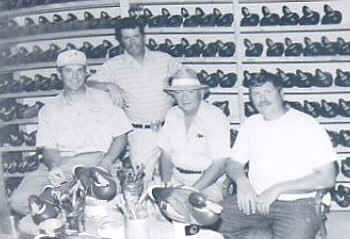|

|
After
about three
and a half minutes,
just as Harry was
beginning another story,
the words
“Sold Out” flashed
across the screen. |
|
The
Jobes family has just completed the finishing touches on their latest
order for QVC – 1000 mallards. Capt. Harry Jobes is seated in the
center surrounded by his sons
(l. to r.) Charles, Joey and Bobby |
.
. . |
Jobes family makes decoy
history
By C. John Sullivan
Printed in Decoy Magazine
January/February 1996
Archiving the history of decoys –the who, what where and
why of this uniquely American folk art – is of vital interest to collectors,
otherwise its legacies will be lost for all time. Few collectors consider the
sale of contemporary decoys as decoy history. But how about if it concerns the
sale of 625 working mallard drakes in three and a half minutes? Definitely
amazing, almost unbelievable and most assuredly history.
Last June the Jobes family of Aberdeen and Havre de Grace,
Maryland – Captain Harry and sons Bobby, Charles and Joey – were
considered for a special QVC show, a major home shopping network, that
included the sale of unique handcrafted items from Maryland. A demonstration was
held to pick 20 artisans from a total of 400 applicants, and the Jobes family
was selected. The initial order was for 600 decoys and there was only 60 days to
complete the birds. The Jobes family took it in stride and each family member,
including the wives, was assigned specific parts of the process.
On October 22, 1995, the family appeared live on front
cameras at Rash Field in Baltimore’s Inner Harbor. Captain Harry did the
talking while the boys whittled heads nonstop. As Harry talked , the television
showed the item number and price. After about three and a half minutes, just as
Harry was beginning another story, the words “Sold Out” flashed across the
screen. Not only did the decoys sell out, but and additional “back order” of
another 75 decoys was placed. This was modern day decoy history. But that’s
not all, the decoys were so popular, that QVC is bringing them back again, this
time in March, this time with 1000 mallard drakes!
While the Jobes make lathe-turned bodies, don’t think of
them as machine make decoys. It’s a labor intensive task utilizing highly
developed artistic skills. The wood block is cut, band sawed, lathe turned, draw
knifed, spoke shaved and sanded. The wood for the heads are cut with a bandsaw
from a pattern, then are hand carved and nailed to the body. The decoys are then
ballasted and a ring and staple is attached. For an antiqued finish the wood is
scorched with a flame and brushed, then the paint process begins.
To witness the painting of
a Jobes’ family decoy is to watch a well-oiled machine. Hiring two
assistants to help with the order, Clarence “Titbird” Bauer and William
“Wolly” Boyd, the family works in a perpetual nonstop process. Each decoy is
passed from one to another in a continuous motion as each artist applies his
particular area of paint and color. What starts as a brown body is quickly
transformed into a brightly colored, beautifully feathered counterfeit of a
mallard drake. Equally amazing is the nonstop dialog. The stories, the joking,
the camaraderie and the brotherly love (although the boys would never want this
made public) is truly a unique occurrence in this computer age.
Over 100 years ago, not far from this Havre de Grace
location the Holly family made working decoys. The time was different, but the
decoy making process and the assignment was nearly identical. In the 1800’s
gunning clubs placed large orders for canvasbacks. This large order of mallards
is not for a gunning club, but for a television club of shoppers. Looking at the
full shelves, with nearly 1000 decoys in place, one can feel history in the
making. The boisterous talk and heartfelt laughter is likely identical to the
camaraderie of any decoy shop throughout the years. Taking a final look at
Captain Harry with a smile spread across his face, one can clearly see a great
evidence of pride. About 100 years ago, John “Daddy” Holly must have
experienced a similar pride as he watched his sons follow in his footsteps. This
is indeed a part of the history of decoys and decoy making, and a sense of
excitement surrounds the opportunity to have witnessed it.
